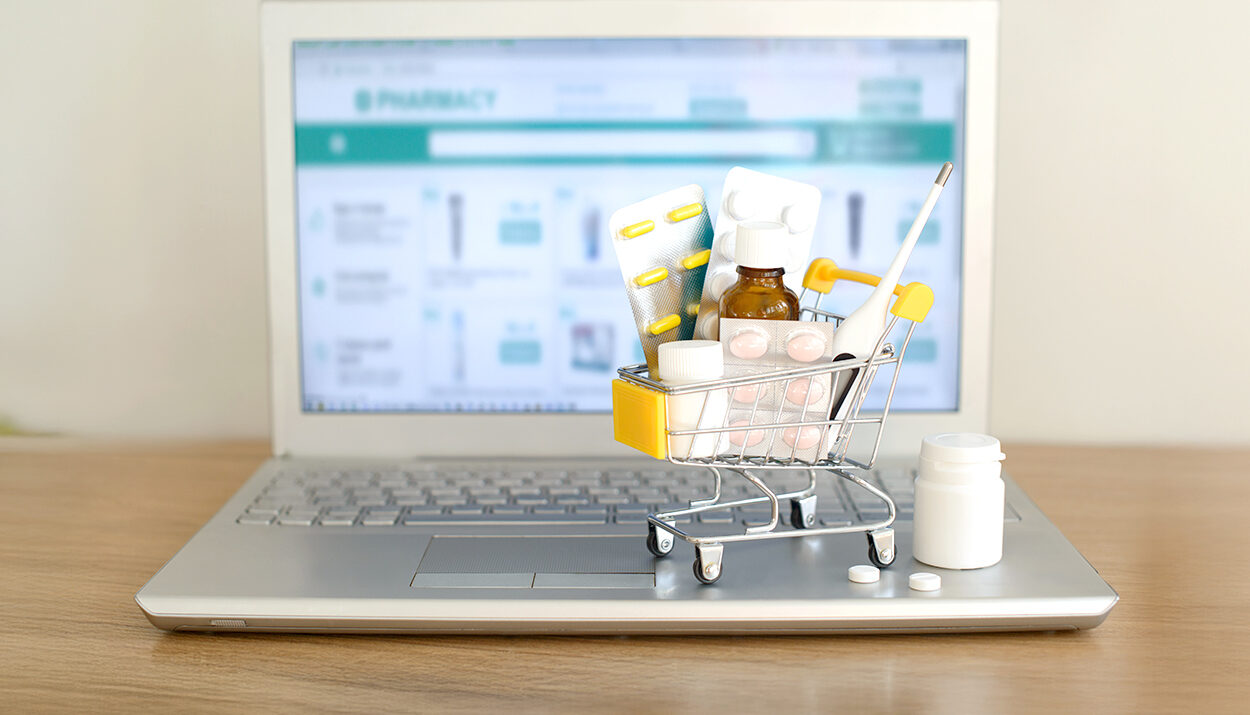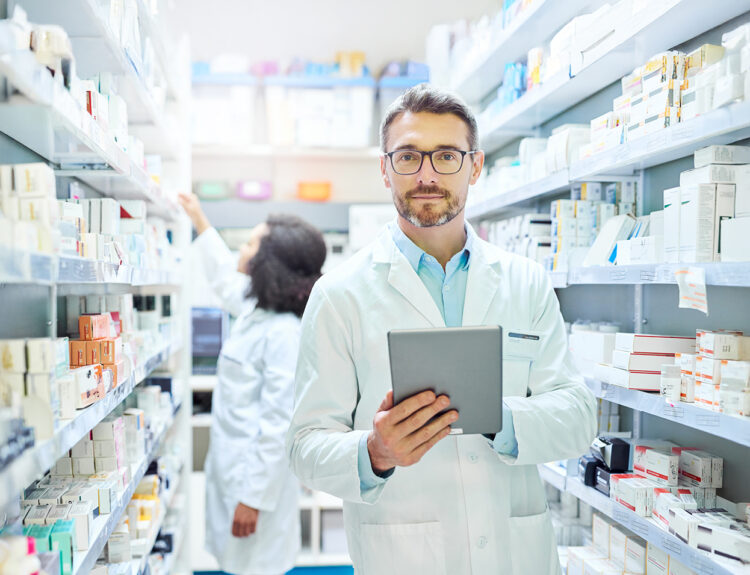It is not uncommon to see an elderly lady getting her prescription filled up automatically with the help of a mobile app installed by her children. The same lady finds equal measure of convenience visiting her neighborhood pharmacist to talk about the nagging back pain since the last two days.
Do you see the scenario here?
While digital pharmacies are all about convenience, human care can actually save lives.
As prescriptions move to apps and mobiles, can you afford to lose the local pharmacists who know your name? Can online and offline pharmacies coexist, or is this going to be a “winner-takes-all” war?
Let us discover how these approaches can work in unison to transform patient care.
How ‘Click’ Trumps ‘Human Touch’
Digital pharmacies are no longer niche retailers. Capsule, Amazon Pharmacy, and the digital segment of CVS Health now have millions of customers, providing:
- 24/7 Convenience: People can fill prescriptions even at 2 AM from the comfort of their homes.
- AI-Powered Tools: Computational checks for drug interactions are quicker than human analysis.
- Cost Reduction: Mail-order generics cost less with lower overhead.
But there are challenges. According to a JAMA study in 2024, 43% of patients distrust online platforms because they fear data privacy and patchwork state-level rules create compliance challenges.
On that note, let us read ahead on how traditional pharmacies enable trust.
How Brick-and-Mortar Pharmacies Go Beyond Algorithms

Despite the digital surge, traditional pharmacies remain indispensable. They are strong because of the human connection, which is something that algorithms cannot duplicate. Many individuals prefer to talk about pharmaceutical side effects in person.
This preference is based on safety as much as comfort.
Pharmacists who interact with patients face-to-face detect minor behavioral indications through hand tremors or side effects reluctance. Such symptoms could indicate opioid dependency issues together with advanced Parkinson’s disease indications.
Traditional pharmacies also excel in complicated care situations. Dosage management of warfarin, opioid stewardship program coordination, or treatment of polypharmacy in elderly patients takes subtle judgment.
While digital transformation in pharmaceutical industry brings immense convenience, there is something enduring about your local pharmacist. Just entering their store to be greeted with a warm smile is what makes many of us continue seeking medication here (and a moment of one-to-one conversation with a familiar face).
This feeling can never be replicated by the cold, robotic algorithms of apps.
Points of Tension Between Digital and Traditional Pharmacies
The clash between digital and traditional pharmacies isn’t just about technology; it’s a battle of trust, access, and survival.
Here’s where tensions are likely to arise:
1. Cost, Speed, and Experience
Sure, digital pharmacies save you money with bulk generics and let you refill prescriptions at 2 AM in your pajamas. But there is a catch. Research shows that 70% of patients want to meet pharmacists in person to handle their complex healthcare needs. These may include situations like knowledge of tricky side effects or on managing chronic conditions. Patients can obtain immediate emergency care at traditional pharmacies. So they have your back now, not in two days. So overall experience will play a tug-of-war between the two formats.
2. Regulatory Challenges
The National Association of Boards of Pharmacy reports that 96% of online pharmacies in the U.S. function illegally. Now, you certainly don’t want your loved one’s health being compromised by dubious drugs that don’t offer any benefit, and instead, harm them. At least with your corner pharmacy, you know exactly who’s offering that pill bottle. So, here, the local pharmacy has a distinct edge over some far off digital pharmacy.
3. Data Privacy Risks
Digital platforms face distrust from healthcare workers due to cybersecurity fears. While they offer slick app reminders, we also have to remember that they might come with a scary headline: “Data Breach Exposes Millions of Prescription Records!” As such, it becomes difficult to trust a faceless algorithm with your private health details.
Traditional pharmacies avoid these risks. While they aren’t perfect, you get the assurance that they are not selling our info to the highest bidder, either. Yes, at the same time, we need to keep in mind that they lack the convenience of app-based tracking or AI-driven reminders.
These disparities between the two formats of dispensing medication can put patients’ health at risk. So, we might see an individual with diabetes in a “pharmacy desert” waiting days for mail-order insulin, whereas an urban customer pays more for in-store convenience.
Closing these gaps demands collaboration, not competition. On that note, let us see how will pharmacy change in the future, and what we need to know about it?
The Curious Case for ‘Patient-First’ Coexistence
The future of pharmacy is not an either-or proposition, it’s a fusion of digital speed and human know-how. Hybrid plans are already showing promise. Pharma transformation combines ease with real-time care, covering both busy professionals and those who crave reassurance.
Telepharmacy innovations create substantial advantages for people living in rural areas. Through video conferencing, telepharmacy sites network patients with pharmacists without the need to travel.
A case in point is the Connecticut telepharmacy program that offered medication therapy management to 96 elderly patients. As an outcome of this approach, the program managed to save $300,000!
Why Does Coexistence Matters?
At this point, you might be wondering “Why the need for this coexistence?” The answer depends largely on the demographics of the target medicine users. Therefore, while digital pharmacies are on the rise, patient preferences are increasingly diverging, shaped strongly by factors like age and specific healthcare needs.
For instance, many seniors rely on the local pharmacists for education on usage and adherence. They can also use the pharmacy records, patient profile, and refill records to give a fairly accurate idea of the patient’s pill usage adherence.
While urbanites prefer doorstep deliveries, rural users may face a “pharmacy desert”, where a single store can turn out to be a lifeline. Even chronic illness sufferers would straddle both worlds. They might prefer refilling statins online, but others like to discuss chemo treatment side effects in person with the friendly, neighborhood pharmacist.
These points aptly depict why the need for coexistence between the two formats is the need of the hour today.
Pharmacists’ New Role in the Hybrid Future of Pharmacy
As the boundaries between digital support and in-person care blur, pharmacists are entering new territory. No longer mere dispensers of medication, they’re transitioning to healthcare navigators who meld technical know-how with human kindness. The overlap of nostalgia and futurism will take place only when the pharmacist adapts well with a forward-looking mindset.
Gone are the days when pharmacists simply counted pills and slapped labels on bottles. The explosion of telehealth, AI, and health apps has transformed them into hybrid healthcare powerhouses. It will not be surprising to see them act as part medication expert, part tech guru, and full-time patient advocate.
Here’s how their profession is changing the future of pharmacy:
1. Opening Up Care Via Technology

- Virtual Consultations: Pharmacists now advise patients through video calls, responding to queries regarding side effects or drug interactions. For instance, a working mom can video-call her pharmacist during lunch break rather than going to a clinic.
- Remote Monitoring: Pharmacists monitor whether patients take drugs on time through apps such as Medisafe. If one misses doses of blood pressure medication, the pharmacist receives an alert and follow-up.
- AI Collaborations: Systems such as IBM Watson enable pharmacists to review patient information more quickly. They can identify trends such as increased blood sugar levels, and recommend dosage changes before issues become acute.
2. New Competencies for New Challenges
To succeed in hybrid care, pharmacists are acquiring:
- Technical Competence: How to work with telehealth systems, AI systems, and wearable device information.
- Patient Education: Developing simple-to-view video tutorials or social media posts about complicated drugs.
- Cultural Competency: Engaging with multilingual patients online through translation software or culturally specific materials.
3. Collaboration is Key
Pharmacists are collaborating with:
- Doctors: Exchanging real-time information on patient compliance to modify treatment regimens.
- Tech Companies: Assisting in the development of apps that are easy to use and medically sound.
- Community Health Workers: Assisting vulnerable patients through hybrid systems (e.g., educating elderly patients to use pill-reminder apps).
These points prove a singular fact: the future of pharmacy profession isn’t replaced by tech; they’re augmented by it. By becoming proficient with both digital tools and in-person care, they provide patients with the best of both: the convenience of apps and the reassurance of a trusted professional.
Technological Innovations Bridging the Gap
New digital innovation in pharmaceutical industry is breaking down boundaries between digital and conventional models. Blockchain, for example, is making drugs more traceable. IBM’s Hyperledger platform helps a patient to track the medical professional’s credentials and experience in a decentralized Blockchain ledger. This improves the trust factor in patients. So when you are in two minds about whether a physician is apt for resolving your health problem, then this platform will help. You can pick the ideal doctor with the insights provided by it.
Smart lockers are another technological advance filling gaps in access. Johns Hopkins Hospitals utilize temperature-managed lockers for 24/7 pharmacy pickup of specialty medications, providing the convenience of automation and institutional credibility.
AI-augmented Electronic Health Records (EHRs), meanwhile, are revolutionizing the monitoring of adherence. Epic’s system flags pharmacists when the digital refill history of a patient indicates non-adherence, ensuring early interventions. These advancements reveal the bright future of pharmacy technology.
Patient-centered Approaches to Contemporary Pharmacy
Personalized care is the foundation of pharma transformation. For diabetes and other chronic conditions, apps such as MySugr facilitate refills and glucose monitoring, while in-clinic settings provide HbA1c testing and nutrition counseling. Elderly care is also changing tremendously! Medicare Advantage plans combine mail-order meds with free home delivery for mobility-impaired seniors. With this step, they can keep getting the prescribed meds on time without worrying about stepping out to get their meds refilled.
Mental health treatment illustrates this synergy. Online sites offer anonymous access to SSRIs, minimizing stigma for patients suffering from depression or anxiety. Simultaneously, pharmacists in communities monitor for side effects such as weight gain or insomnia through regular visits, providing a backup system that sole online models cannot offer.
In Summary
Pharmacies online won’t replace the local pharmacy. Rather they will enhance the efficacy of the conventional pharmacy. The future of pharmacy is for models that combine AI efficiency with human empathy. So, a cancer survivor can video-call her pharmacist at midnight or hug the one who has known her for decades. As healthcare evolves, collaboration, not competition, will mark success.

Pharmacists, your experience is critical in helping to construct this hybrid future of pharmacy. Join MDForLives to voice your opinions on such future-centric topics.
You can connect with fellow healthcare professionals, earn rewards for participating in medical surveys, and contribute to shaping the future of patient care.
FAQs
-
How are digital pharmacies different from traditional ones?
While traditional pharmacies offer in-person services, digital pharmacies are available online with home delivery. Both are included in hybrid models.
-
Are digital pharmacies secure?
Legitimate sites employ HIPAA-compliant technology but always check for state licensure.
-
Can I speak with a pharmacist online?
Absolutely! Sites like NowRx provide live chats, but complicated situations need in-person appointments.
-
What are the things traditional pharmacies can do that digital ones cannot?
They can do same-day emergency access, hands-on vaccinations, and complicated medication compounding.
-
Will digital pharmacies eliminate traditional pharmacies?
Not likely. Patients prefer to have both.
References:

MDForLives is a vibrant community of healthcare professionals and patients dedicated to shaping the future of healthcare. We provide valuable global insights to healthcare companies through online surveys, interviews, and discussion forums.






